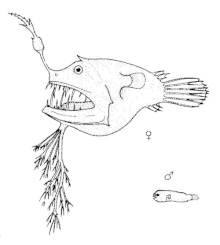Linophryne
| Linophryne Temporal range: Late Miocene to Recent PreꞒ Ꞓ O S D C P T J K Pg N | |
|---|---|
 | |
| L. arborifera | |
 | |
| L. lucifer | |
| Scientific classification | |
| Domain: | Eukaryota |
| Kingdom: | Animalia |
| Phylum: | Chordata |
| Class: | Actinopterygii |
| Order: | Lophiiformes |
| Family: | Linophrynidae |
| Genus: | Linophryne Collett, 1886 |
| Type species | |
| Linophryne lucifer Collett, 1886[3] | |
| Synonyms[3] | |
Linophryne, the bearded seadevils, is a genus of marine ray-finned fishes belonging to the family Linophrynidae, the leftvents. These deep sea anglerfishes are found in the Atlantic, Indian and Pacific Oceans.
Taxonomy
Linophryne was first proposed as a monospecific genus in 1886 by the Norwegian zoologist Robert Collett when he described L. lucifer as a new species.[3] Collett gave the type locality of L. lucifer as off Madeira at around 36°N, 20°W.[4] The 5th edition of Fishes of the World classifies this genus within the family Linophrynidae, which it places within the suborder Ceratioidei, the deep sea anglerfishes, within the order Lophiiformes, the anglerfishes.[5]
Etymology
Linophryne prefixes linos, which means "net", an allusion Collett did not explain when he proposed the genus, with phryne, meaning "toad". The prefix may be a reference to the sac like mouth hanging off the trunk, which in the holotype contained a lanternfish, like a fisherman's keep net. The second part phryne is commonly used in the names of anglerfish genera. Its use may date as far back as Aristotle and Cicero, who referred to anglerfishes as "fishing-frogs" and "sea-frogs," respectively, possibly because of their resemblance to frogs and toads.[6]
Species
Linophryne contains 22 recognised species, these are divided into 3 subgenera:[7]
- Subgenus Linophryne Collett, 1886
- Linophryne algibarbata Waterman, 1939
- Linophryne arcturi Beebe, 1926
- Linophryne argyresca Regan & Trewavas, 1932
- Linophryne bicornis Parr, 1927
- Linophryne bipennata Bertelsen, 1982
- Linophryne coronata Parr, 1927
- Linophryne escaramosa Bertelsen, 1982
- Linophryne lucifer Collett, 1886
- Linophryne macrodon Regan, 1925
- Linophryne maderensis Maul, 1961
- Linophryne polypogon Regan, 1925
- Linophryne racemifera Regan & Trewavas, 1932
- Linophryne sexfilis Bertelsen, 1973
- Linophryne trewavasae Bertelsen, 1978
- Subgenus Rhizophryne Bertelsen, 1982
- Linophryne andersoni Gon, 1992
- Linophryne arborifera Regan, 1925
- Linophryne brevibarbata Beebe, 1932
- Linophryne densiramus S. Imai, 1941 (Thickbranch angler)
- Linophryne parini Bertelsen, 1980
- Linophryne pennibarbata Bertelsen, 1980
- Subgenus Stephanophryne Bertelsen, 1982
- Linophryne indica Brauer, 1902 (Headlight angler)
- Linophryne quinqueramosus Beebe & Crane, 1947
Gallery






Characteristics
Linophryne leftvents are sexually dimorphic and the metamorphosed females can be distinguished from the other leftvent genera by a number of characters. These include the possession of a hyoid barbel, well-developed spines on the sphenotic bone and the preoperculum and a single nearly oval bulb on the esca with a short projection in its middle and has no appendages as well as a low number of fin rays in the dorsal and anal fins.[8] The largest species in the genus is L. lucifer which has a maximum published standard length of 27.5 cm (10.8 in).[7]
Distribution and habitat
Linophryne is found circumglobally in all three Oceans[7] from as far north as Iceland and Greenland in the Atlantic Ocean[9] they are found at depths between 0 and 2,200 m (0 and 7,218 ft).[10][11]
Fossil record
Linophryne is represented in the fossil record by what may be L. indica was found in Late Miocene strate of Los Angeles, California, along with a fossil of the related Borophryne apogon, during the construction of a metrorail.[1]
References
- ^ a b CARNEVALE, GIORGIO; THEODORE W. PIETSCH; GARY T. TAKEUCHI; RICHARD W. HUDDLESTON (2008). "Fossil ceratioid anglerfishes (Teleostei: Lophiiformes) from the Miocene of the Los Angeles Basin, California" (PDF). Journal of Paleontology. 82 (5): 996–1008. Bibcode:2008JPal...82..996C. doi:10.1666/07-113.1. S2CID 129926776. Archived from the original (PDF) on 2016-03-03. Retrieved 2012-07-19.
- ^ CARNEVALE & PIETSCH "THE DEEP-SEA ANGLERFISH GENUS ACENTROPHRYNE (TELEOSTEI, CERATIOIDEI, LINOPHRYNIDAE) IN THE MIOCENE OF CALIFORNIA" Journal of Vertebrate Paleontology 29(2):372–378, June 2009 [1] Archived 2016-03-03 at the Wayback Machine
- ^ a b c Eschmeyer, William N.; Fricke, Ron & van der Laan, Richard (eds.). "Genera in the family Linophrynidae". Catalog of Fishes. California Academy of Sciences. Retrieved 22 August 2024.
- ^ Eschmeyer, William N.; Fricke, Ron & van der Laan, Richard (eds.). "Species in the genus Linophryne". Catalog of Fishes. California Academy of Sciences. Retrieved 22 August 2024.
- ^ Nelson, J.S.; Grande, T.C.; Wilson, M.V.H. (2016). Fishes of the World (5th ed.). Hoboken, NJ: John Wiley & Sons. pp. 508–518. doi:10.1002/9781119174844. ISBN 978-1-118-34233-6. LCCN 2015037522. OCLC 951899884. OL 25909650M.
- ^ Christopher Scharpf (22 August 2024). "Order LOPHIIFORMES (part 2): Families CAULOPHRYNIDAE, NEOCERATIIDAE, MELANOCETIDAE, HIMANTOLOPHIDAE, DICERATIIDAE, ONEIRODIDAE, THAUMATICHTHYIDAE, CENTROPHRYNIDAE, CERATIIDAE, GIGANTACTINIDAE and LINOPHRYNIDAE". The ETYFish Project Fish Name Etymology Database. Christopher Scharpf. Retrieved 21 June 2024.
- ^ a b c Froese, Rainer; Pauly, Daniel (eds.). "Species in genus Linophryne". FishBase. June 2024 version.
- ^ Bañón, Rafael; Pietsch, Theodore & Piñeiro, Carmen (2006). "New record of Linophryne coronata, (Lophiiformes, Linophrynidae) from the North-eastern Atlantic Ocean". Cybium: International Journal of Ichthyology. 30: 385–386.
- ^ Carpenter, K.E.; Robertson, R.; Matson, C. & Rivera Higueras, M. (2019). "Linophryne bicornis". IUCN Red List of Threatened Species. 2019: e.T140191559A140323028. doi:10.2305/IUCN.UK.2019-3.RLTS.T140191559A140323028.en. Retrieved 22 August 2024.
- ^ Froese, Rainer; Pauly, Daniel (eds.). "Linophryne maderensis". FishBase. June 2024 version.
- ^ Froese, Rainer; Pauly, Daniel (eds.). "Linophryne lucifer". FishBase. June 2024 version.











